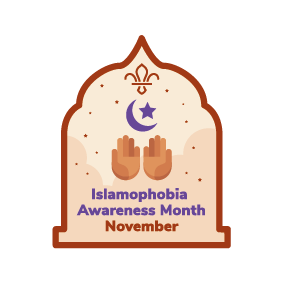Make caring cards for the local community
You’ll need
- A4 card
- Pens or pencils
- Coloured pens or pencils
- Glue sticks
- Scissors
- Envelopes
- Items to decorate the cards
Before you begin
- Use the safety checklist to help you plan and risk assess your activity. Additional help to carry out your risk assessment, including examples can be found here. Don’t forget to make sure all young people and adults involved in the activity know how to take part safely.
- Make sure you’ll have enough adult helpers. You may need some parents and carers to help if you’re short on helpers.
Planning this activity
- Put the equipment out for everyone to use. Make sure there’s enough card for everyone to have their own piece.
- Think about who or any occasion you’d like everyone to create cards for. Don’t forget to ask the group what they think – is there a particular event, place or person they’d like to make cards for?
- You could make cards for a care home, hospices, nursery, hospital or place in the local community.
- You could create cards for celebrations, such as Christmas, Hanukkah, Diwali, Eid, Easter or birthdays. You could use your cards to mark an occasion, such as Remembrance.
- Decide who you’ll give your cards to and get in touch to make sure the intended recipient is happy to receive cards by post or in person. Remember to ask the group what they think – and double check that you have the right address too.
Story time
- Everyone should sit in a circle.
- Someone should read Practising Kindness by Annabel Rose. Make sure to save a copy of this story before the session.
- After reading the story, everyone should take some time to reflect on it as a group. We’ve included some questions to help you reflect in the pink box below.
Tomasz wasn’t having a good day. He’d woken up late so he had to get dressed in a rush, and on the way to school he’d stood in a great big puddle that made his socks soggy.
He got some spare socks, then went to his favourite place: the art area. Tomasz sat down and started to paint. His paintbrush swooped across the page as he created a beautiful picture of a fierce red dragon.
He was just washing his brush, about to add the finishing touches, when – clatter! He knocked the water all over his painting. The colours started to run, and Tomasz’s eyes filled with tears.
‘That’s so sad. But it’s OK, Tomasz,’ said Tomasz’s friend, Morgan. ‘I’ll help you make a new picture.’
Morgan got a new sheet of paper, and together they drew an even better picture of a dragon and her castle.
‘Thanks, Morgan!’ said Tomasz.
It was time to play outside so Tomasz grabbed his teddy. He swung on the swings. He dug in the sandpit. He collected fallen leaves. He played chase. And then Tomasz realised that he’d lost his teddy. He started to sniffle.
‘Losing things is hard,’ said Flo. ‘But it’s OK, Tomasz. Your teddy’s just having his own adventure. Let’s go and find him!’
Tomasz and Flo went back around the playground. Teddy wasn’t playing chase. He wasn’t near the big pile of leaves. He wasn’t hiding in the sandpit. So they headed to the swings – and there was Tomasz’s teddy.
‘Thank you, Flo!’ said Tomasz.
Finally, it was snack time. Tomasz carried his food over to the table really carefully. He was nearly there when he tripped and spilled his snack all over the floor.
‘Oh no,’ Tomasz mumbled. ‘Everything’s going wrong!’
‘Oops!’ said Kendra. ‘It’s OK, Tomasz. I’ll help you clear it up.’
Kendra helped Tomasz pick up his snack, and then Kyle shared some food that hadn’t been on the floor.
‘Thanks!’ said Tomasz. ‘You’re the best.’
Before long, it was time for the grown-ups to collect everyone.
‘How was your day?’ asked Tomasz’s dad.
‘Well,’ said Tomasz. ‘It was almost all bad. But then lots of people made it better.’
By Annabel Rose
Card creations
- Gather everyone together and explain you’re going to make cards to show kindness and spread joy in your local area.
- Ask people what they think they could decorate the cards with or what messages they could write. They could include supportive messages or words, write a thank you message, include drawings of things used during the celebration, or just make it bright and colourful.
- People should decorate their card while having fun being as creative as they want to be. An adult may need to help with cutting or sticking if people find it tricky.
- When the cards are finished (and dry, if anyone used glue or paint), people should write a kind message inside their cards. An adult may need to help with this. You could also write a message for people to copy or have printed messages people can stick into the card.
- Remember to remind people not to include any personal information about themselves and to sign the card from the group, rather than using their own name.
- Once the cards are finished, gather everyone in a circle. If they want to, people can show their cards or read out their message to the rest of the group. They could read their kind message out if they want to.
- Gather all the cards and put them in envelopes. You may need to put your cards in a few envelopes if you’re sending them to different places. It’s useful to write the address on each envelope, even if you’re delivering them yourself.
You can decide how you want to deliver the cards. It may be best an adult volunteer delivers the cards after the session, either to a postbox or to the venue.
Reflection
This activity encouraged everyone to take an active role in their community, think about others and help make a positive difference. During this activity everyone had the opportunity to learn about a celebration or occasion and how they could create a card to help someone else mark it.
Practising kindness
- When has someone helped you feel better?
- How does giving someone a card help or encourage them?
Card creations:
- Celebrating different occasions helps people to learn new things. What did everyone learn about the celebration they made cards for?
- Did anyone help their friends with their cards? How did it feel to help?
Delivery time:
- How do people think their cards make others feel?
- How did it feel to help other people feel happy or cared about?
Safety
All activities must be safely managed. You must complete a thorough risk assessment and take appropriate steps to reduce risk. Use the safety checklist to help you plan and risk assess your activity. Always get approval for the activity, and have suitable supervision and an InTouch process.
- Scissors
Supervise young people appropriately when they’re using scissors. Store all sharp objects securely, out of the reach of young people.
- Glue and solvents
Always supervise young people appropriately when they’re using glue and solvent products. Make sure there’s plenty of ventilation. Be aware of any medical conditions that could be affected by glue or solvent use and make adjustments as needed.
- Road safety
Manage groups carefully when near or on roads. Consider adult supervision and additional equipment (such as lights and high visibility clothing) in your risk assessment.
If anyone needs extra support to make their card, let them work closely with a partner to create a card together.
If someone doesn’t want to read their kind message out, they could ask someone else to read it out for them. They also don't have to have their message read out if they feel uncomfortable doing so.
All Scout activities should be inclusive and accessible.
Now you've created a card for one celebration or occasion, why not have a think about another one and create cards at home with the people you live with?
You could even create a card for a celebration or occasion that you haven’t taken part in before.
Give everyone the opportunity to choose the celebration or occasion they want to create the cards for.
It doesn’t matter if different people make their cards for different reasons.

